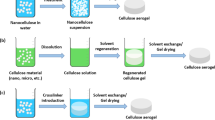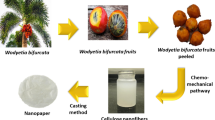Abstract
Chitosan (CS) was synthesized by gamma irradiation of chitin extracted from shrimp shell wastes. CS nanofibers (CS-NFs) with a diameter of 500 nm were prepared using forcespinning method. The obtained CS-NFs were then used to adsorb uranium (U) from aqueous solution. Under optimal conditions, pH 6 and contact time 210 min, the maximum U adsorption was 142 mg g−1. The results showed that CS-NFs adsorb U from aqueous media based on the Langmuir isotherm model. Also, kinetic studies showed that the adsorption process follows a pseudo-second-order model.









Similar content being viewed by others
References
Tchounwou PB, Yedjou CG, Patlolla AK, Sutton DJ (2012) Heavy metals toxicity and the environment. Experientia Suppl 101:133–164
Van Suc N, Ly HTY (2011) Adsorption of U(VI) from aqueous solution onto modified chitosan. Int J ChemTech Res 3:1993–2002
Gregorio C (2005) Recent development in polysaccharide-based materials used as adsorbents in wastewater treatment. Prog Polym Sci 30:38–70
Wan Ngah WS, Endua CS, Mayanar R (2002) Removal of copper (II) ions from aqueous solution onto chitosan and cross-linked chitosan beads. React Funct Polym 50:181–190
Pollard SJT, Fowler GD, Sollars CJ, Perry R (1992) Low-cost adsorbents for waste and wastewater treatment: a review. Sci Total Environ 116:31–52
Wang G, Liu J, Wang X, Xie Z, Deng N (2009) Adsorption of uranium (VI) from aqueous solution onto cross-linked chitosan. J Hazard Mater 168:1053–1058
Babel S, Kurniawan TA (2003) Low-cost adsorbents for heavy metals uptake from contaminated water: a review. J Hazard Mater B 97:219–243
Sureshkumar MK, Das D, Mallia MB, Gupta PC (2010) Adsorption of uranium from aqueous solution using chitosan-tripolyphosphate (CTPP) beads. J Hazard Mater 184:65–72
Bakar NHHA, Tan WL (2016) Natural composite membranes for water remediation: toward a sustainable tomorrow. In: Ahmad M, Ismail M, Riffat S (eds) Renewable energy and sustainable technologies for building and environmental applications. Springer, Cham
Mousavi S, Shahraki F, Aliabadi M, Haji A, Deuber F, Adlhart C (2019) Surface enriched nanofiber mats for efficient adsorption of Cr(VI) inspired by nature. J Environ Chem Eng 7:102817
Wang R, Guan S, Sato A, Wang X, Wang Z, Yang R, Hsiao BS, Chu B (2013) Nanofibrous microfiltration membranes capable of removing bacteria, viruses and heavy metal ions. J Membr Sci 446:376–382
Sabetzadeh N, Gharehaghaji AA (2017) How porous nanofibers have enhanced the engineering of advanced materials: a review. J Text Polym 5:57–72
Shi X, Zhou W, Ma D, Ma Q, Bridges D, Ma Y, Hu A (2015) Electrospinning of nanofibers and their applications for energy devices. J Nanomater 2015:140716
Esfahani H, Jose R, Ramakrishna S (2017) Electrospun ceramic nanofiber mats today: synthesis, properties, and applications. Materials 10:1238
Padron S, Fuentes A, Aruntu CD, Lozano K (2013) Experimental study of nanofiber production through forcespinning. J Appl Phys 113:024318
Almetwally AA, El-Sakhawy M, Elshakankery M, Kasem MH (2017) Technology of nano-fibers: production techniques and properties—critical review. J Text Assoc 78:5–14
Xu F, Weng B, Gilkerson R, Materon LA, Lozano K (2015) Development of tannic acid/chitosan/pullulan composite nanofibers from aqueous solution for potential applications as wound dressing. Carbohydr Polym 115:16–24
Rahman MM, Kabir S, Rashid TU, Nesa B, Nasrin R, Haque P, Khan MA (2013) Effect of γ-irradiation on the thermomechanical and morphological properties of chitosan obtained from prawn shell: evaluation of potential for irradiated chitosan as plant growth stimulator for Malabar spinach. Radiat Phys Chem 82:112–118
Kasaai MR (2007) Calculation of Mark–Houwink–Sakurada (MHS) equation viscometric constants for chitosan in any solvent–temperature system using experimental reported viscometric constants data. Carbohydr Polym 68:477–488
Zainol I, Akil H, Mastor A (2009) Effect of γ-irradiation on the physical and mechanical properties of chitosan powder. Mater Sci Eng C 29:292–297
El-Nesr EM, Raafat AI, Nasef SM, Soliman EA, Hegazy EA (2013) Chitin and chitosan extracted from irradiated and non-irradiated shrimp wastes (comparative analysis study). Arab J Nucl Sci Appl 46:53–66
Czechowska-Biskup R, Jarosinska D, Rokita B, Ulanlki P, Rosiak JM (2012) Determination of degree of deacetylation of chitosan comparison methods. Prog Chem Appl Chitin Deriv 17:5–20
Peng F, Rea L, Xu F, Bian J, Peng P, Sun RC (2009) Comparative study of hemicelluloses obtained by graded ethanol precipitation from sugarcane bagasse. J Agric Food Chem 57:6305–6317
Haider S, Park S-Y (2009) Preparation of the electrospun chitosan nanofibers and their applications to the adsorption of Cu(II) and Pb(II) ions from an aqueous solution. J Membr Sci 328:90–96
Sangsanoh P, Supaphol P (2006) Stability improvement of electrospun chitosan nanofibrous membranes in neutral or weak basic aqueous solutions. Biomacromol 7:2710–2714
Gu BK, Park SJ, Kim MS, Kang CM, Kim J, Kim C-H (2013) Fabrication of sonicated chitosan nanofiber mat with enlarged porosity for use as hemostatic materials. Carbohydr Polym 97:65–73
Li WC, Victor DM, Chakrabarti CL (1980) Effect of pH and uranium concentration on interaction of uranium(VI) and uranium(IV) with organic ligands in aqueous solutions. Anal Chem 52:520–534
Parab H, Joshi S, Shenoy N, Verma R, Lali A, Sudersanan M (2005) Uranium removal from aqueous solution by coir pith: equilibrium and kinetic studies. Bioresour Technol 96:1241–1248
Yi Z, Li J (2012) Removal of uranium(VI) from aqueous solution by dry chitosan powder. Adv Mater Res 366:434–443
Hosseini M, Keshtkar AR, Moosavian MA (2016) Electrospun chitosan/baker’s yeast nanofibre adsorbent: preparation, characterization and application in heavy metal adsorption. Bull Mater Sci 39:1091–1100
Pang C, Liu Y, Cao X, Hua R, Wang C, Li C (2010) Adsorptive removal of uranium from aqueous solution using chitosan-coated attapulgite. J Radioanal Nucl Chem 286:185–193
Kutahyalı C, Eral M (2004) Selective adsorption of uranium from aqueous solutions using activated carbon prepared from charcoal by chemical activation. Sep Purif Technol 40:109–114
Meroufel B, Benali O, Benyahia M, Benmoussa Y, Zenasni MA (2013) Adsorptive removal of anionic dye from aqueous solutions by Algerian kaolin: characteristics, isotherm, kinetic and thermodynamic studies. J Mater Environ Sci 4:482–491
Tan KL, Hameed BH (2017) Insight into the adsorption kinetics models for the removal of contaminants from aqueous solutions. J Taiwan Inst Chem Eng 74:25–48
Simonin JP (2016) On the comparison of pseudo-first order and pseudo-second order rate laws in the modeling of adsorption kinetics. Chem Eng J 300:254–263
Niu Y, Ying D, Li K, Wang Y, Jia J (2016) Fast removal of copper ions from aqueous solution using an ecofriendly fibrous adsorbent. Chemosphere 161:501–509
He J, Sun F, Han F, Gu J, Ou M, Xu W, Xu X (2018) Preparation of a novel polyacrylic acid and chitosan interpenetrating network hydrogel for removal of U(VI) from aqueous solutions. RSC Adv 8:12684–12691
Author information
Authors and Affiliations
Corresponding author
Additional information
Publisher's Note
Springer Nature remains neutral with regard to jurisdictional claims in published maps and institutional affiliations.
Rights and permissions
About this article
Cite this article
Rostamian, R., Firouzzare, M. Preparation of forcespun γ-irradiated chitin from shrimp shell wastes and its evaluation as uranyl ion adsorbent. J Radioanal Nucl Chem 329, 731–739 (2021). https://doi.org/10.1007/s10967-021-07862-1
Received:
Accepted:
Published:
Issue Date:
DOI: https://doi.org/10.1007/s10967-021-07862-1




